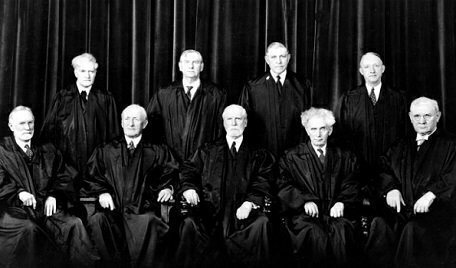Senator Marco Rubio plans to propose a new constitutional amendment to permanently limit the Supreme Court to nine Justices. While Rubio faces a difficult task, the effort does raise some questions.
 “To prevent the delegitimizing of the Supreme Court, I will introduce a constitutional amendment to keep the number of seats at nine. There is nothing magical about the number nine,” Rubio said in an editorial published on Wednesday. “It is not inherently right just because the number of seats on the Supreme Court remains unchanged since 1869. But there is something inherently good and important about preventing the further destabilization of essential institutions.”
“To prevent the delegitimizing of the Supreme Court, I will introduce a constitutional amendment to keep the number of seats at nine. There is nothing magical about the number nine,” Rubio said in an editorial published on Wednesday. “It is not inherently right just because the number of seats on the Supreme Court remains unchanged since 1869. But there is something inherently good and important about preventing the further destabilization of essential institutions.”
Rubio is responding to reports that some Democrats would consider using congressional powers to change the number of Justices on the Court if they were to regain control of the White House and both chambers of Congress in 2021. In one past incident in 1937, such efforts were called “court-packing” and proved to be unpopular.
One question is why would Rubio propose an amendment to set a permanent number of Justices? The constitutional amendment route requires two-thirds of the House and Senate to approve Rubio’s amendment text - a very high bar indeed. And then three-quarters of the states need to ratify the amendment. Given the current ideological split in Congress, such an effort faces long odds. (The second Article V option, which allows the states to propose and ratify amendments, is a bigger long shot, as it has never been successfully called.)
The answer is that under the Constitution, the number of Supreme Court Justices is not fixed, and Congress can change it by passing an act that is then signed by the President. Article III, Section 1, starts with a broad direction to Congress to establish the court system: “The judicial Power of the United States, shall be vested in one supreme Court, and in such inferior Courts as the Congress may from time to time ordain and establish.”
And as Rubio said, the number of Justices has changed over time. The Judiciary Act of 1789 established the first Supreme Court, with six Justices. In 1801, President John Adams and a lame-duck Federalist Congress passed the Judiciary Act of 1801, which reduced the Court to five Justices in an attempt to limit incoming President Thomas Jefferson’s appointments. Jefferson and his Democratic-Republicans soon repealed that act, putting the Court back to six Justices. Then, in 1807, Jefferson and Congress added a seventh Justice when Congress added a seventh federal court circuit.
In early 1837, President Andrew Jackson was able to add two additional Justices after Congress expanded the number of federal circuit court districts. Under different circumstances, Congress created the 10th Circuit in 1863 during the Civil War, and the Court briefly had 10 Justices. Congress then passed legislation in 1866 to reduce the Court to seven Justices. That only lasted until 1869, when a new Judiciary Act sponsored by Senator Lyman Trumbull put the number back to nine Justices, with six required at a sitting to form a quorum. (President Ulysses S. Grant eventually signed that legislation and nominated William Strong and Joseph Bradley to the newly restored seats.)
Since then, aside from President Franklin Roosevelt’s ill-fated threat in 1937 to add new Justices who sympathized with his policies to the Supreme Court, the number of Justices on the Court has remained stable.
Roosevelt was particularly upset by the Court’s 1935 decision in Schechter Poultry Corp. v. United States. The unanimous decision invalidated a key part of the National Industrial Recovery Act, one of the projects passed during FDR's 100-day program in 1933. President Roosevelt did not mince words a week later when he talked to the press. “You see the implications of the decision. That is why I say it is one of the most important decisions ever rendered in this country,” Roosevelt told reporters on May 31, 1935. “We have been relegated to the horse-and-buggy definition of interstate commerce.”
As Roosevelt started his second term, he used one of his fireside chats in March 1937 to make his case to the American people for adding more Justices to the Supreme Court who agreed with him. “This plan of mine is not attacking of the court; it seeks to restore the court to its rightful and historic place in our system of constitutional government and to have it resume its high task of building anew on the Constitution ‘a system of living law.’ The court itself can best undo what the court has done,” Roosevelt said.
The legislation struggled to gain traction and it was opposed not only by Chief Justice Charles Evans Hughes but also by Justice Louis Brandeis and members of Roosevelt’s Democratic Party. Soon, changing voting patterns on the Court along with vacancies made the court-packing plan a moot point.
Another recent idea proposed by Court reform advocates to place term limits on Supreme Court Justices raises a different set of constitutional questions. One theoretical question is if term limits match the Founders’ intent when the Constitution was written. Another is how term limits for the Supreme Court would be enacted.
Many, but not all, scholars believe a constitutional amendment is needed to place term limits on Supreme Court Justices. But in a 2017 petition from the group Fix The Court, 21 law professors proposed implementing term limits using an act of Congress.
Scott Bomboy is the editor in chief of the National Constitution Center.







